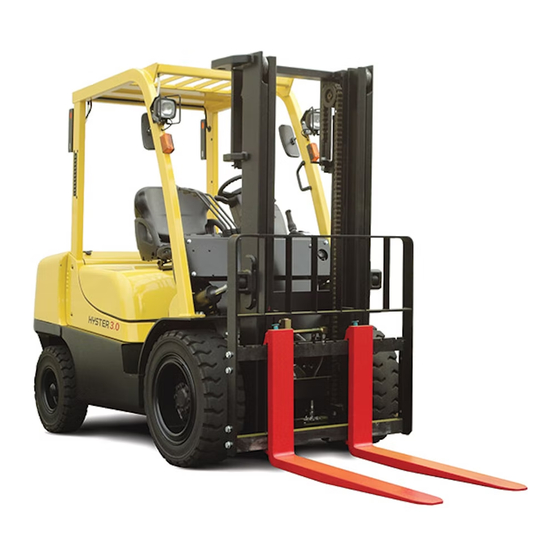
Summarization of Contents
Model Description
General Information
Overview of lift truck models covered in the manual.
Operator Protection Equipment
Details on load backrest extension and overhead guard safety.
Nameplate Information
Explains the importance and content of the truck's nameplate.
Chassis and Serial Number Location
Identifies where to find chassis and serial numbers for reference.
Pre-operation and Periodic Inspections
Guidelines for ensuring safe and efficient truck operation through inspections.
New Truck Handling
Instructions for the initial break-in period of a new lift truck.
Nameplate Installation Details
Shows the locations of safety labels and nameplates on the truck.
Main Components Identification
Visual guide to the primary parts of the lift truck.
Controls and Instrument Panel
Control Lever and Pedal Configurations
Describes controls for different transmission types and pedal layouts.
Key Switch Functions
Explains the operation and positions of the ignition key switch.
Dash Display and Indicator Icons
Details the various icons and displays on the instrument panel.
Gauges, Meters, and Warnings
Explains how to read the hourmeter, coolant, and fuel gauges.
System Warnings and Service Intervals
Covers low battery warnings and recommended service interval indicators.
Control Functions and Settings
Explains speed/load meters, display modes, clock, and alarm settings.
Safety Devices and Interlocks
Details travel and cargo interlock functions for operator safety.
Levers and Their Operation
Describes the function of control levers like direction, lift, and tilt.
Pedal Operation
Explains the use of accelerator, brake, and inching pedals.
Fuel System Controls and RTV Feature
Covers fuel changeover switch and Return to Vertical function.
Truck Structure and Stability
Understanding Truck Stability
Explains how load and truck balance affect stability.
Center of Gravity Principles
Details how combined CG affects lift truck stability.
Stability Range and Load Capacity
Defines stability limits and how to read capacity tables.
Loading and Safety Operation
Load Handling Procedures
Step-by-step guide for safely picking up and moving loads.
Load De-stacking Procedures
Instructions for safely removing loads from stacks.
Load Stacking Procedures
Guidelines for safely placing loads onto shelves or stacks.
Pre-Work Safety Checks
Ensures operator preparedness and safe work environment before starting.
Safe Travel Practices
Covers speed limits, visibility, and maneuvering during travel.
Safe Work Practices
Guidelines for safe operation during various work tasks.
Parking Procedures and Safety
Proper steps for parking the lift truck safely.
How to Drive
Pre-Drive Checks and Seat Adjustment
Essential checks before operating and adjusting the operator's seat.
Engine Starting Procedures
Step-by-step guide for starting gasoline, LPG, and diesel engines.
Post-Start Procedures and Warm-up
Checks after starting the engine and warming up the truck.
Driving and Acceleration Control
Guidelines for safe driving, acceleration, and deceleration.
Fuel Handling and Seasonal Care
Covers fuel changeover, LPG safety, and seasonal care.
Inspection
Pre-operational Inspection Checklist
Comprehensive list of checks before daily operation.
Tire, Hub Nut, and Light Inspections
Procedures for checking tires, nuts, lights, and mirrors.
Fluid System Inspections
Checks for sedimenter, radiator, engine oil, and hydraulic oil levels.
Electrical and Pedal System Checks
Inspecting battery fluid, brake fluid, and pedal operation.
Brake, Steering, and Control System Checks
Verifying the proper function of brakes, steering, and parking brake.
Display and Operational Checks
Inspecting the dash display, gauges, and operational controls.
Post-Operation and Storage
Procedures after finishing work and for storing the truck.
Scheduled Maintenance Intervals
Outlines periodic, weekly, and monthly inspection requirements.
Component-Specific Maintenance
Details on inspecting oils, filters, spark plugs, and drains.
Bolt Torque and Fastener Checks
Verifying torque and tightness of critical bolts.
Work Items
Engine Oil and Filter Replacement
Steps for changing engine oil and oil filter.
Fuel System Maintenance Procedures
Sedimenter draining and bleeding air from the fuel system.
Brake System Adjustment
How to adjust the parking brake lever.
Fuse Checks and Electrical Troubleshooting
Locating and identifying fuses for the electrical system.
Starting with a Discharged Battery
Safe procedures for jump-starting the lift truck.
Tire Changing and Wheel Installation
Step-by-step guide for changing tires and installing wheels.
Truck Washing Guidelines
Proper methods for washing the lift truck, protecting components.
Service Data
Lubricants and Parts Replacement Schedule
Table detailing recommended lubricants and replacement intervals.
Safety Parts Replacement Schedule
List of safety-critical parts and their recommended replacement years.
Main Specification Table
Vehicle Body Dimensions Diagram
Visual representation of truck dimensions.
ICE Lift Truck Specifications
Detailed technical specifications for various models.













Need help?
Do you have a question about the H2.5XT and is the answer not in the manual?
Questions and answers